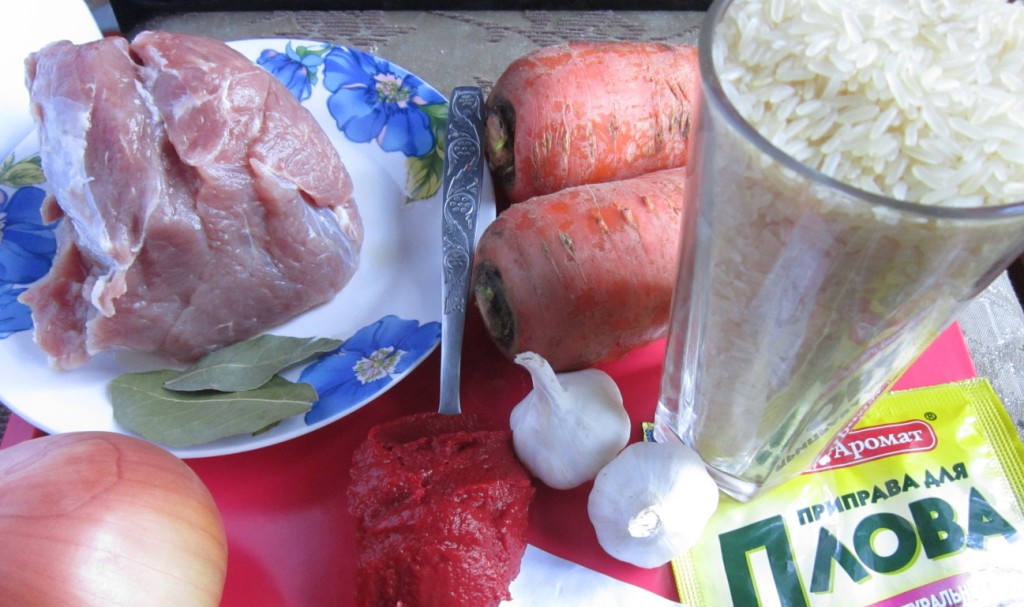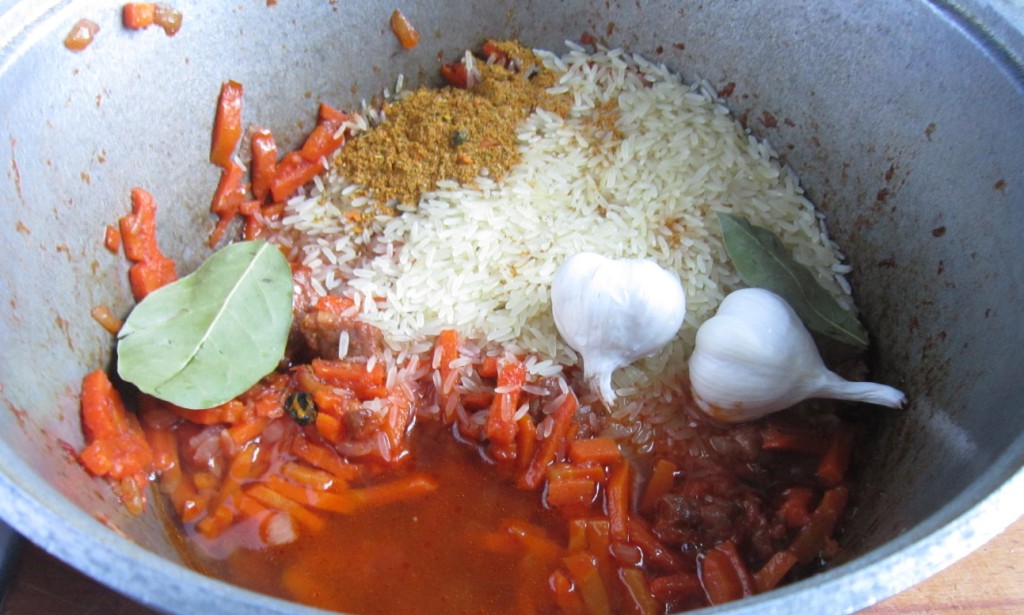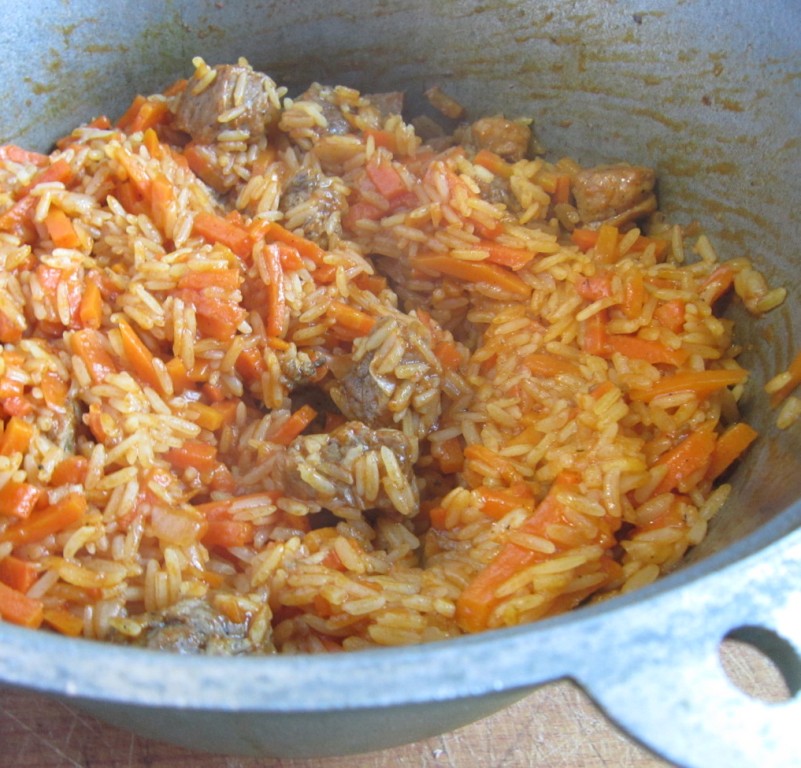From this article we will learn how to cook Uzbek pilaf. There are many recipes for this dish. “Pilav” is prepared both in the Middle and the Middle East. And in Uzbekistan itself, every city and even a small region has its own variants of this delicious and satisfying dish. To begin, consider the difference between pilaf and other cereal from rice. Firstly, it should turn out friable. In this he differs from the Spanish paella. But she, like a real Uzbek pilaf, is preparing in a cauldron. But the Italian risotto is baked in the oven. And pilaf does not at all look like sticky Russian rice porridge. The original recipe for this dish involves the use of only lamb, as well as fat tail fat. But over time, pilaf began to be cooked not only with other types of meat (and even fish), but also with different cereals: wheat, sorghum (dzhugara), peas, mash, corn. The cauldron and open fire also ceased to be unchanged, giving way to a large frying pan with high walls.
Cooking basics
Pilav is a very ancient dish. It is believed that the original recipe appeared in India or the Middle East in the third century BC. A classic recipe for Uzbek pilaf has been known since the sixteenth century. The principle of preparation of this dish is quite simple. Pilaf consists of two parts. The first is called Zirvak. And the second is cereal. Seems to be easier? However, the success of the whole dish depends on the rice variety. You should not take round groats, especially designed for sushi. It has a lot of gluten, and pilaf will not come out friable. Much attention is also paid to the components of zirvak. In the Uzbek version of pilaf, meat must be calcined. Further, unlike other types of this dish, zirvak and rice are combined in a cauldron for further joint cooking. In general, in order to cook a real Uzbek pilaf, you need to have knowledge and experience. It is not for nothing that this particular dish option was included in the UNESCO list in 2016 as an intangible asset of mankind.

Products for pilaf
As for rice, the use of an Uzgen variety with red grains is ideal. It is also called Dev Zira. A good option would also be Basmati. Acceptable are white Chinese long-grain Jasmine, as well as a mixture of wild Parbloid with steamed. Now consider the products for zirvak - the main part of the Uzbek pilaf. This is lamb, fat tail fat, in which meat, onions, special yellow carrots, garlic and zira will be fried. Such a set of products is mandatory (basic). Turks say: “There are as many recipes for pilaf as there are cities in the Muslim world.” And as for Uzbekistan, there is a set of additional products for the dish in Tashkent, Samarkand, Bukhara, Ferghana and many other settlements of the country. Barberry, saffron, dried fruits and even pumpkin are added to pilaf.
What to remember when cooking
In Uzbekistan, there is a pilaf-like dish - shawlya. It consists of the same products - rice, meat, carrots, fats. But their proportion is slightly different. And the sequence of bookmarking products is different. As a result, shawl has a taste very different from pilaf. This is a fatter and less crumbly dish. Jokingly, the shawl is called an ineptly prepared or unsuccessful Uzbek pilaf. So that you do not get exactly this dish instead of what you want, you need to strictly adhere to the sequence of bookmarking products and, most importantly, proportions. It is important not to overdo it with fat. But if it is not enough, the dish may burn. A kilogram of lamb requires the same amount of carrots and 200 grams of rice. And fat is melt exactly 350 grams.
Uzbek pilaf: recipe in a cauldron
If you absolutely want to cook an authentic dish, not adapted to the conditions of a city apartment, you must be the owner of two things. The first is a thick-walled large cauldron, preferably cast iron. It goes without saying that an open fire or barbecue should be attached. Therefore, the most delicious pilaf is prepared outside the house. You should also have fat tail fat on hand. At this point, the Uzbeks themselves often deviate from the rule. Fat tail fat is too heavy for the stomach, interrupts the aroma of spices and adds unnecessary fat to the dish. Therefore, authentic Uzbek pilaf is often cooked in cottonseed oil. But it also starts to bitter when heated. Therefore, it is most appropriate to make pilaf in olive or unrefined sunflower oil. Begin cooking with rice. We rinse it several times until the liquid becomes completely transparent. If you do not have Devzira or Basmati, leave the rice in the last water. So a little more starch will leave the grains.
Cooking Zirvak
The Uzbek classic recipe for pilaf recommends starting the process with warming the cauldron and calcining the oil. But this is on condition that all products for zirvak have already been prepared. But to wash the lamb, remove the lard and cut the pulp into cubes is not five minutes. In addition, you need to peel three bulbs and chop them in half rings. A whole kilogram of carrots - not young, juicy, but old, dry - cut into thick strips. And you also need to remove the top, dirty husk from two heads of garlic, but do not peel them completely and do not separate them into cloves. When all the ingredients for zirvak are prepared, you can put the cauldron on a large flame. When it heats up, drop the fat tail fat cut into pieces. When it is completely flooded, we pick up the cracker with a slotted spoon. If we use vegetable oil, just wait for the appearance of a gray haze. Put the onion in the husk. When she gives all the juice and blackens, we catch it and throw it away. Add the chopped onion now. Fry until golden. Carefully, so as not to get burned, we put meat in a cauldron.

"Soul of pilaf"
Uzbeks call these poetic phrases not lamb, but carrots. It is she who determines the taste of the dish. If you do not have a special yellow carrot, take the usual, orange, but it should be autumn, that is, dry. Spread the straw on top of the browned meat and fry, without touching, for three minutes. Then mix and cook for another 10 minutes. Now the turn of spices has come. The recipe for Uzbek pilaf in a cauldron requires the mandatory use of a tablespoon of zira, known here as cumin. All other spices are up to you. You can add to the cider a pinch of saffron and coriander seeds or pour a tablespoon of dry barberry. If you want to cook a delicious Uzbek pilaf with dried fruits (prunes, dried apricots, raisins), then they also need to be added to the cauldron at this stage. But they should be pre-steamed with boiling water, dried and fried in a pan. Pour boiling water so that the liquid is a centimeter and a half above the zirvak. We spread the heads of garlic and pepper pod in the center of the cauldron. If the latter is not dry, but fresh, you need to lay it later. Reduce the heat to a minimum and cook for forty minutes. Add more salt than usual. Why? Rice absorbs excess. Take the garlic. At this stage, lay a fresh pod of red pepper.

We connect zirvak and groats
Fire increase to the maximum. Carefully strain the rice and send it to the cauldron. Fill with a liter (preferably a little less, you can add water later) boiling water. We are waiting for it to boil. Reduce the heat to medium. When the water is absorbed, the garlic is returned to the place in the middle of the cauldron. When the rice is ready, we make punctures with a stick throughout the depths of the Uzbek pilaf. This will allow liquid from the lower layers to come to the surface and evaporate. After that we cover the cauldron with a plate, and over it with a lid. Reduce the fire to a minimum and simmer for another half an hour.
How to cook Uzbek pilaf at home
But what if you want to cook a delicious meal in a city apartment, but you don’t have a cauldron? Really have to abandon this venture? Not at all. A cauldron can successfully replace a duckweed. It also stores heat well and distributes it over the entire surface. And to make fire is more or less more convenient with a gas stove than with an open fire. True, the haze will no longer be. But if you know how to cook Uzbek pilaf correctly, then the aroma of the dish will be unsurpassed anyway. The only thing that needs to be considered when cooking a dish in a chicken bowl is that the contents after the last addition of boiling water should be stirred. Otherwise, the rice on the bottom will burn, and the top will remain damp.